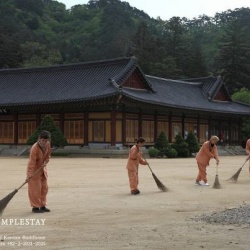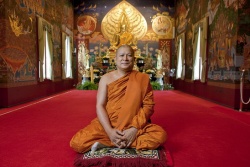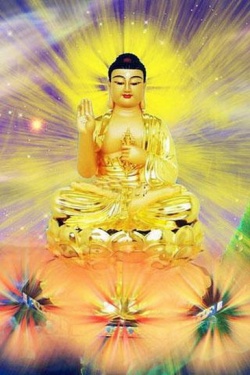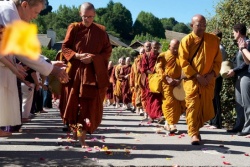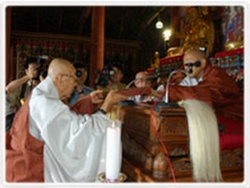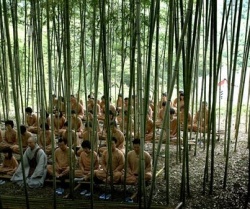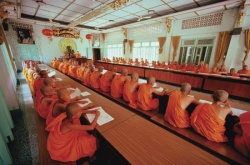The Higher Ordination Ceremony of Buddhist Monk (Upasampada- Kamma)
It is considered to be a fascinating subject to read the description of various ceremonies performed on the occasion of promoting a novice (or a deacon, or a neophyte) to the rank of a Buddhist monk ('Bhikkhu'in Pali). This Upasampada Ordination which the candidate has to receive confers a peculiarly sacred character and give a special religious power to him. It inspires him to a more perfect course of life and enlists him as a full-fledged member of the community of monks, the Samgha.
It is sincerely believed that the Ordination ceremony helps him to get out of the secular profane society and enrolls him into the sacred community. By this performance the Frathernity of Samgha helps to raise him from the inferior state of layman to that of a Bhikkhu monk a superior state of virtue and perfection.
Whoever he may be, a layman or a neophyte, or a probationer, or a deacon, the candidate must necessarily be initiated as a novice, the lower ordination of pabbajja, before he can receive the higher ordination for the monkshood. The first essential qualification to become a candidate for admission to the Order of monks is that one must be of the male sex. Only men are eligible for candidacy. Moreover, he must be free from communicable diseases and from debts; he must be neither illegitimate nor a slave; he must have acquired the consent of his parents; he must be at least twenty years of age; and he must be provided for the ordination ceremony with a proper suit of three yellow robes (civara) 2 and an alms bowl (patta)3. To sum up the candidate must be examined systematically so that he is sure to be exempt from certain moral and physical defects and deformities, that would render him unworthy of being admitted as a member of the Pristine Holy Older of Monks. The candidate must willingly pledge himself to a sincere observance of monastic disciplinary rules and regulations which form the Vinaya constitutions of the Samgha Order. This is mentioned in the scriptures as the first essential aspect of higher ordination as Vatthu,4the personal eligibility.
The second essential aspect of ordination is Sima, the Ordination Hall5, especially established and reserved for such monastic functions. This special building or rather a boundary is set apart from lay people and animals who are not permitted to enter nor to approach closer than the marble stone stakes that surround the hall as the sign of boundary demarcation, during the performance of the monastic rites and ceremonies. Usually the time and date for the ordination rites are fixed by astrological calculations.
The third essential aspect of ordination of monk is the number of participants in the ceremony; and a minimum of four bhikkhus is mandatory to form an appropriate Chapter of monks-Samgha. The eldest one will preside over the occasion as the Chairman of the Assembly or the Preceptor (Upajjha yacariya) of the newly ordained monk. Another elder monk will act as a Counsellor or Instructor (Anusasaka) who is going to present the candidate to the Assembly for thorough examination. This Counsellor will help the candidate by admonishing him on certain points, the ignorance of which would prove highly prejudicial to and greatly offensive in a professed member of the Order. The third elder monk will read the authorised words of ritual from the prescribed book of compendium (Kammavaca6 in Pali) on palm leaves, or on lacquered paper, or even on copper plates-which are usually enclosed within beautifully ornamented silk wrappers and gilded covers. In some cases when the participant monks are more than four, readers are selected to read the Kammavaca in groups of three and to repeat the reading three times.
The remaining colleagues of the Assembly remain solemnly to witness the successful Ordination of a new brother by the Samgha.
The fourth important aspect in the ordination ceremony is the Declaration of the Announcer or the Master of the Ordination ceremony that the Assembly is going to Ordain a candidate into the Order lawfully, This is called in Pali technical term as Natti. 7 The announcement must be articulate and understandable so that the participants shall unanimously and solemnly approve the performance.
The fifth and most important aspect in the Ordination ceremony is the reading of Kammavaca by the Readers, selected by the Chairman of the Assembly for this occasion. Kammavaca is the ecclesiastical scriptures or the ceremonial compendium prescribed to be read in the Ordination ceremonies and other monastic rites. Each and every syllable in the text must be read articulately with perfect accent and pronunciation.
These are five essential aspects of monastic Ordination, to transform the candidate into full-fledged bhikkhu or Upasampanna; or Pancanga; hence U Pan-cin or U Pazin8 in Burmese colloquium.
All the ordinances and prescriptions in these texts (Kammavaca) are promulgated and sanctioned by the Lord Buddha himself who was the final authority in the Monastic Order. So the responsible readers must read very carefully and articulately to pronounce the right sound of each word. Therefore all orthodox members of the Buddhist Monastic Order bear due respect and profound veneration to the contents of the Kammavaca text.
Bearing in mind, then, the significance of higher ordination ceremony of a monk (bhikkhu or Upasampada) for the entire Burmese Buddhist society it is well to consider its impact upon the individual concerned.
For the purpose of greater immediacy of presentation and more lively in reading, the narrative henceforth should be in terms of the first person.
In the previous pages. I have described a traditional ceremony of initiation of a novice in the Burmese Buddhist Order of Monks which compels all Buddhist boys to reside a longer or shorter period in a monastery as a compulsory requirement for their religious experience.
Henceforth some brief information about my personal experience of the Higher Ordination of a Monk in the Burmese Buddhist tradition is to be presented.
It was in 1946 when I visited everyday the monastery where my only younger brother was residing as a (temporary) novice. Consequently I became quite intimate and acquainted with the residential monks there. Then I decided to become an Upasampada Bhikkhu monk like them inspired for many good reasons. I discussed the matter with the local prelate-Sayadaw who counselled me to read the (Vinaya) book of Monastic Disciplinary Rules in Burmese translation. The prelate interviewed me more than once to consider whether I was eligible to become a monk. Satisfied with my qualifications, he advised me to obtain the willing consent of my parents who were still living then.
When I reported the matter to the prelate Sayadaw that all the necessary preparations had been made in accordance with his instructions, he calculated and fixed the day of the Ordination ceremony. And he directed me to be initiated again as a novice and stay for a week in the monastery to learn all the ritualistic words by heart which I had to recite on the day of ordination. Accordingly one week prior to the fixed date I had gone through the initiation ceremony to pass a term of instruction as a novice. Then I had several rehearsals with the help of a Counsellor monk to be sure that the ceremony would be celebrated successfully on the appointed day. My sponsor was very particular about the perfection in the eight requisites of a monk (Attha parikkhara). He told me that the candidate, prior to the Ordination ceremony must be provided with the eight requisites, namely:—
1. an alms bowl (patta)9
2. an upper garment (sanghati)
3. an upper robe (uttarasanga)
4. an underwear (antara vasaka)
5. a water strainer (dhammakarana)
6. a girdle (kaya bandhana)
7. a razor (vasika)
8. a needle with thread (suci).
He then explained to me the importance of these requisites without which I could not be admitted into the Order.
Patta,3 the alms-bowl is a black pot, round and smooth and made of earth or iron. It has a lid to cover it, and a stand. In the beginning ...............
To be continued
1. Upasampada - Kamma: Higher Ordination
2. civara:Yellow Robes
3. Patta: alms bowl; see Nisaggiyapacittiya rules on patta in the Patimokkha text.
4. Vatthu: Personal eligibility
5. sima:Ordination Hall, Chapel House
6. Kammavaca: Ecclesiastical Scriptures
7. Natti: Announcement
8. U Pazin (Burmese): Bhikkhu
